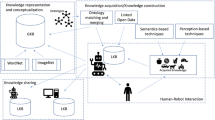Abstract
The present work deals with development of a Soft-Computing-based intelligent system allowing to discover autonomously the surrounding world and to learn new knowledge about it by semantically interacting with human. The learning is accomplished by observation and by interaction with a human. We provide experimental validation of the proposed concept using as well simulated environment as implementing the approach on a humanoid robot in a real-world environment. We show, that our approach allows a humanoid robot to learn without negative input and from small number of samples.















Similar content being viewed by others
Notes
Developed by the ICL at University of Stuttgart, available online at http://www.ims.uni-stuttgart.de/projekte/corplex/TreeTagger.
References
Araki T, Nakamura T, Nagai T, Funakoshi K, Nakano M, Iwahashi N (2011) Autonomous acquisition of multimodal information for online object concept formation by robots. In: Proceedings of IEEE/IROS, pp 1540–1547
Berlyne DE (1954) A theory of human curiosity. Br J Psychol 45:180–191
Bowerman M (1983) How do children avoid constructing an overly general grammar in the absence of feedback about what is not a sentence? Papers Rep Child Lang Dev 22:23–35
Coradeschi S, Saffiotti A (2003) An introduction to the anchoring problem. Robot Auton Syst 43:85–96
de Greeff J, Delaunay F, Belpaeme T (2009) Human-robot interaction in concept acquisition: a computational model. In: Proceedings of IEEE 8th international conference on development and learning, pp 1–6
Goodrich MA, Schultz AC (2007) Human–robot interaction: a survey. Found Trends Hum Comput Interact 1(3):203–275
Holland JH (1992) Adaptation in natural and artificial systems: an introductory analysis with applications to biology, control and artificial intelligence. MIT Press, Cambridge
Kang MJJ, Hsu M, Krajbich IM, Loewenstein G, McClure SM, Wang JTT, Camerer CF (2009) The wick in the candle of learning: epistemic curiosity activates reward circuitry and enhances memory. Psychol sci 20(8):963–973
Karray FO, De Silva CW (2004) Soft computing and intelligent systems design: theory, tools and applications. Addison Wesley, USA. ISBN: 0321116178
Kay P, Berlin B, Merrifield W (1991) Biocultural implications of systems of color naming. J Linguist Anthropol 1(1):12–25
Klingspor V, Demiris J, Kaiser M (1997) Human–robot-communication and machine learning. Appl Artif Intell 719–746
Litman JA (2008) Interest and deprivation factors of epistemic curiosity. Personal Individ Differ 44(7):1585–1595
Liu T, Yuan Z, Sun J, Wang J, Zheng N, Tang X, Shum HY (2011) Learning to detect a salient object. In: Proceedings of computer vision and pattern recognition, Los Alamitos, pp 353–367
Lütkebohle I, Peltason J, Schillingmann L, Wrede B, Wachsmuth S, Elbrechter C, Haschke R (2009) The curious robot–structuring interactive robot learning. In: Proceedings of the IEEE international conference on robotics and automation (ICRA‘09), pp 2154–2160
Madani K, Sabourin C (2011) “Multi-level cognitive machine-learning based concept for human-like “artificial” walking: application to autonomous stroll of humanoid robots”, special Issue on Linking of phenomenological data and cognition. Neurocomputing 74:1213–1228 (Elsevier)
Madani K, Ramik DM, Sabourin C (2012) Multi-level cognitive machine-learning based concept for artificial awareness: application to humanoid robot’s awareness using visual saliency. J Appl Comput Intell Soft Comput Hindawi Publ Corp. doi:10.1155/2012/354785
Meger D, Forssén PE, Lai K, Helmer S, McCann S, Southey T, Baumann M, Little JJ, Lowe DG (2008) Curious George: an attentive semantic robot. Robot Auton Syst 56(6):503–511
Minsky M, Papert S (1988) Perceptrons: an introduction to computational geometry, expanded edn. MIT Press, Cambridge
Moreno R, Ramik DM, Graña M, Madani K (2012) Image segmentation on the spherical coordinate representation of the RGB color space. IET Image Process 6(9):1275–1283
Ramík DM, Madani K, Sabourin C (2013) A cognitive approach for robots’ autonomous learning. In: Proceedings of the 12th international work-conference on artificial neural networks (IWANN’13), Puerto de la Cruz. LNCS series, vol 7902. Springer, New York, pp 309–320
Ramik DM, Sabourin C, Madani K (2013) A machine learning based intelligent vision system for autonomous object detection and recognition. J Appl Intell. Springer. doi:10.1007/s10489-013-0461-5
Ramik DM, Sabourin C, Madani K (2013) Autonomous knowledge acquisition based on artificial curiosity: application to mobile robots in indoor environment. J Robot Auton Syst Elsevier 61(12):1680–1695
Ramik DM, Sabourin C, Madani K (2013) From visual patterns to semantic description: a cognitive approach using artificial curiosity as the foundation. Pattern Recognit Lett Elsevier 34(14):1577–1588
Regier T (1995) A model of the human capacity for categorizing spatial relations. Cognit Linguist 6(1):63–88
Saunders J, Nehaniv CL, Lyon C (2010) Robot learning of lexical semantics from sensorimotor interaction and the unrestricted speech of human tutors. In: Proceedings of the 2nd international symposium on New Frontiers Human-Robot Interact. ASIB Convent
Schindler M, Goethe JW (1964) Goethe’s theory of colour applied by Maria Schindler. New Knowledge Books, East Grinstead
Skocaj D, Kristan M, Vrecko A, Mahnic M, Janicek GJ, Kruijff M, Hanheide M, Hawes N, Keller T, Zillich M, Zhou K (2011) A system for interactive learning in dialogue with a tutor. In: Proceedings of IEEE/IROS, pp 3387–3394
Waxman SR, Gelman SA (2009) Early word-learning entails reference, not merely associations. Trends Cognit Sci 13(6):258–263
Wellens P, Loetzsch M, Steels L (2008) Flexible word meaning in embodied agents. Connect Sci 20(2–3):173–191
Yu C (2005) The emergence of links between lexical acquisition and object categorization: a computational study. Connect Sci 17(3–4):381–397
Author information
Authors and Affiliations
Corresponding author
Additional information
Communicated by I.R. Ruiz.
Rights and permissions
About this article
Cite this article
Ramík, D.M., Madani, K. & Sabourin, C. A Soft-Computing basis for robots’ cognitive autonomous learning. Soft Comput 19, 2407–2421 (2015). https://doi.org/10.1007/s00500-014-1495-2
Published:
Issue Date:
DOI: https://doi.org/10.1007/s00500-014-1495-2




